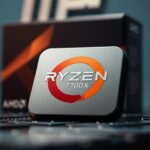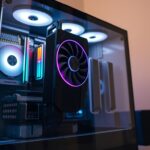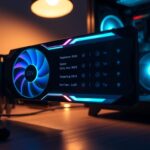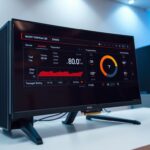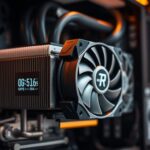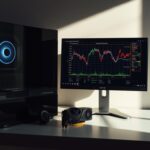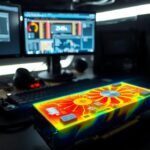Last Updated on August 15, 2025 by Gill
Remember that sinking feeling when your favorite game stutters during a critical moment? Or the frustration of waiting hours for a video render to finish? You’re not alone. Many creative professionals and gamers feel trapped by their laptop’s limitations—until they discover a game-changing solution.
What if I told you that aging laptops can rival premium desktops? The secret lies in harnessing external graphics technology. This innovation lets you keep your trusty machine while gaining desktop-level muscle for modern games and professional software.
I’ve seen students edit 4K videos on five-year-old devices and watched gamers play Cyberpunk 2077 on budget-friendly setups. These aren’t miracles—they’re smart upgrades anyone can achieve. You don’t need to sacrifice portability for performance anymore.
In this guide, we’ll explore:
- Budget-friendly paths to enhanced visual capabilities
- Real-world success stories from streamers and designers
- Technical insights made simple for non-experts
Whether you’re rendering 3D models or battling in Fortnite, the right setup can make your machine feel brand new. Let’s dive into the tools that bridge the gap between mobility and raw graphical power.
Understanding External GPU (eGPU) Technology
Imagine transforming your lightweight laptop into a heavy-hitting workstation between coffee breaks. That’s the magic of modern graphics expansion. These setups breathe new life into portable machines, letting them tackle tasks far beyond their original specs.
What Is an eGPU?
An eGPU acts like a graphics sidekick for your laptop. It’s a desktop-class graphics card living in a portable enclosure that links to your machine through Thunderbolt™ 3 or USB-C. This setup redirects visual processing from your laptop’s weaker internal components to the more robust external device.
The beauty lies in flexibility. You get desktop-level muscle for rendering 4K videos or playing AAA games, then unplug to take your slim laptop anywhere. It’s like having a sports car engine you only attach when needed.
Overview of External Graphics Solutions
Today’s external graphics systems are surprisingly user-friendly. Most work right out of the box—connect the enclosure, install drivers, and you’re ready. They handle everything from Blender animations to VR experiences that would make most built-in GPUs sweat.
Modern enclosures support full-sized desktop cards, letting you upgrade components over time. This approach future-proofs your setup. Whether you’re a casual gamer or a 3D artist, these solutions offer scalable power without locking you into expensive hardware cycles.
Why Use an External GPU for Your Laptop?
Does your current setup struggle with modern titles or creative software? Many users discover their laptops hit performance walls when handling today’s resource-heavy tasks. This is where graphics expansion solutions shine, offering desktop-grade muscle while preserving your device’s portability.
Unlock Premium Visual Experiences
Modern titles like Call of Duty: Warzone demand serious graphical firepower. An external graphics solution delivers buttery-smooth frame rates and crisp details that integrated components can’t match. Streamers gain stable 1080p broadcasts, while designers see render times drop dramatically.
The benefits extend beyond entertainment. Video editors using Premiere Pro report 40% faster 4K exports. 3D artists working in Blender achieve complex scene renders without thermal throttling. It’s like installing a turbocharger in your existing machine.
Stay Ahead of Tech Advancements
New game engines and software updates constantly raise hardware requirements. With an upgradable graphics setup, you can swap cards as needed instead of buying entire systems. Recent Steam surveys show 68% of users keep their primary laptops for 4+ years when using external graphics.
This approach saves money long-term. When next-gen titles arrive, simply upgrade your external card rather than purchasing a premium gaming laptop. Creative professionals appreciate maintaining familiar workflows while accessing cutting-edge rendering capabilities.
Checking Compatibility and System Specifications
Ever plugged in a new gadget only to get an error message? Avoid that frustration by confirming your system’s readiness first. Compatibility checks prevent wasted time and money—critical when boosting your machine’s graphical muscle.
Assessing Laptop Ports and Requirements
Start with your laptop’s Thunderbolt 3 or USB4 port. These high-speed connections act as highways for graphics data. Don’t assume all USB-C ports work—some lack the necessary bandwidth for smooth gameplay or rendering.
Check manufacturer specs like a detective. Brands often list eGPU support in technical documentation. Older systems might need BIOS updates to recognize external graphics hardware. One user discovered their 2019 laptop required firmware tweaks despite having the right port.
Graphics Card and Enclosure Compatibility
Size matters with GPUs. A card that’s too long won’t fit standard enclosures—measure twice before buying. Power demands also vary. High-end cards need robust enclosures with adequate cooling to prevent thermal throttling during marathon sessions.
Balance is key. Pairing a RTX 4080 with a dual-core CPU creates bottlenecks. Match your graphics ambitions with your processor’s capabilities. Entry-level cards often deliver the best value for midrange systems, maximizing performance without overspending.
Preparing Your Laptop for an eGPU Setup
Ever faced a roadblock when trying to boost your machine’s capabilities? Proper preparation prevents most setup headaches. Let’s ensure your device is primed to harness external graphics power without hiccups.
Updating Operating System and Drivers
Start with your operating system. Windows 11 24H2 becomes crucial here—older versions might reject modern graphics hardware. Navigate to Settings > Windows Update to install pending upgrades. This foundation ensures smooth communication between components.
Next, visit your laptop manufacturer’s support page. Download the latest Thunderbolt drivers—these act as translators between your machine and the external setup. Missing this step often causes mysterious “device not recognized” errors during initial connections.
Don’t overlook BIOS updates. Manufacturers frequently release firmware tweaks that improve eGPU compatibility. One user reported a 2022 Dell XPS gaining 30% better performance after a simple BIOS flash. Check your system’s support page monthly for these critical updates.
| Common Mistake | Consequence | Smart Solution |
|---|---|---|
| Skipping OS updates | Driver conflicts | Enable automatic updates |
| Using generic drivers | Unstable connections | Download OEM-specific software |
| Ignoring BIOS updates | Hardware incompatibility | Bookmark manufacturer’s support page |
Adjust power settings to High Performance mode before connecting your graphics dock. This prevents sudden sleep mode activations during rendering sessions. Close unnecessary apps like Chrome tabs—they steal resources needed for driver installations.
Finally, create a system restore point. It takes two minutes but saves hours if configurations go sideways. Think of it as an undo button for your laptop’s software environment.
Essential Components for Connecting an External GPU
Every great setup begins with gathering essential components. Think of these parts as puzzle pieces—each must fit perfectly to unlock your laptop’s hidden potential. Let’s break down what you’ll need to build a reliable graphics expansion system.
Identifying Required Hardware and Accessories
Your laptop needs a Thunderbolt™ 3 or USB4 port with explicit eGPU support. Check manufacturer specs—some ports look identical but lack necessary bandwidth. Recent Lenovo ThinkPads and Dell XPS models often handle this best.
Choose an enclosure that matches your graphics card’s physical size and thermal needs. Compact options work for midrange GPUs, while high-end cards require spacious designs with multiple fans. Power supplies matter too—aim for at least 500W for modern components.
| Component | Key Features | Recommendation |
|---|---|---|
| Enclosure | Cooling capacity, GPU length support | Razer Core X (330mm max) |
| Graphics Card | Power draw, performance tier | NVIDIA RTX 4060 (115W) |
| Thunderbolt™ Cable | 40Gbps bandwidth | Included with enclosure |
| Power Supply | Wattage headroom | +20% over GPU requirements |
Don’t skimp on the cable—use the Thunderbolt™ cable provided with your enclosure for guaranteed compatibility. Third-party options might save money but risk connection drops during intense gaming sessions.
Consider adding an external monitor to maximize your graphics card’s output. Most laptops lose 10-15% performance when using internal displays due to data roundtrips. A 144Hz gaming monitor eliminates this bottleneck completely.
Step-by-Step: How to Connect External GPU to Laptop
Transforming your laptop into a graphics powerhouse requires precise execution. Follow these steps carefully to avoid common pitfalls and ensure peak performance from your upgraded setup.
Installing the Graphics Card into the Enclosure
Start by consulting your enclosure’s manual—every model has unique requirements. Locate the PCIe slot and remove any protective covers. Align your graphics card’s gold connectors with the slot, applying even pressure until it clicks into place.
Secure the card using included brackets or screws. This prevents movement during transport. Connect auxiliary power cables from the enclosure’s PSU to your card. Many users forget this step, leading to boot failures.
| Step | Key Action | Pro Tip |
|---|---|---|
| 1 | Open enclosure | Use anti-static wrist strap |
| 2 | Insert card | Check alignment arrows |
| 3 | Secure hardware | Finger-tighten screws first |
| 4 | Power connections | Listen for click sounds |
Connecting with Thunderbolt™ or USB-C Cables
Use the original cable that came with your enclosure for guaranteed compatibility. Plug the Thunderbolt™ end into your laptop first, then connect to the enclosure. This sequence helps systems recognize the hardware properly.
Wait for the OS detection chime before proceeding. Windows and macOS handle driver installations differently—Windows may require manual downloads, while Apple systems often auto-detect. Update your graphics drivers immediately after setup completes.
Configuring and Testing Your eGPU Setup
Ready to unleash your upgraded system’s full potential? Proper configuration transforms raw power into seamless performance. Let’s optimize your setup for peak results.
Smart Graphics Prioritization
Head to Windows Settings > System > Display > Graphics. Select your eGPU from the dropdown menu. Set it as the default for demanding apps like Premiere Pro or Steam. This tells your system: “Use the heavy lifter for tough jobs.”
Create custom rules for each application. Right-click game shortcuts and choose “Use high-performance processor.” This preserves battery life for everyday tasks while reserving graphics muscle where it matters most.
Stress-Testing Your System
Launch Cyberpunk 2077 or Red Dead Redemption 2—these titles push hardware to its limits. Monitor frame rates with MSI Afterburner. Stable 60+ FPS at 1440p means your setup works as intended.
Watch for thermal patterns during hour-long sessions. Ideal GPU temps stay below 85°C. If performance dips, adjust in-game settings. Lower shadows first—they drain resources but barely affect visual quality.
| Setting | Performance Impact | Visual Tradeoff |
|---|---|---|
| Ray Tracing | High | Dramatic lighting |
| Anti-Aliasing | Medium | Smoother edges |
| Texture Quality | Low | Sharper surfaces |
Compare benchmarks before and after installation. Many users see 2-3x frame rate improvements. Export a 4K video timeline—render times often drop by 40% with proper performance tuning.
Troubleshooting Common eGPU Issues
Ever felt that surge of panic when your graphics boost suddenly fails? Don’t worry—most hurdles have straightforward fixes. Let’s tackle the most frequent speed bumps users encounter with external graphics setups.
Silent BIOS Surprises
Your laptop’s BIOS acts as the gatekeeper for hardware recognition. Outdated firmware often blocks external devices from communicating properly. Head to your manufacturer’s support page and grab the latest BIOS version—many 2023 updates specifically improved eGPU compatibility.
Enable Thunderbolt security settings if your system demands it. Some Lenovo models require switching from “Legacy” to “UEFI” mode. Restart twice after changes—some settings only apply on the second boot.
Power and Connection Mysteries
That flickering enclosure light isn’t decorative. Check your power supply connections first when devices go AWOL. High-wattage GPUs need stable juice—try a different wall outlet if your enclosure stutters during load spikes.
Cables wear out faster than you’d think. Swap Thunderbolt cords if your system shows intermittent recognition. One streamer solved weekly disconnects by replacing a $5 bargain cable with the manufacturer’s original.
| Issue | Quick Fix | Prevention Tip |
|---|---|---|
| Driver conflicts | Run DDU in Safe Mode | Update drivers monthly |
| Overheating | Add cooling pad | Clean vents weekly |
| Performance drops | Disable integrated GPU | Monitor task manager |
For stubborn device recognition issues, uninstall graphics drivers completely before reconnecting your setup. Windows Update sometimes sneaks in generic drivers that clash with NVIDIA or AMD software. Stay persistent—most problems vanish with methodical troubleshooting.
Choosing the Best External Graphics Card for Your Needs
Matching your workflow with the ideal card requires understanding your priorities. The right choice balances your laptop’s capabilities with the graphical demands of your favorite apps and games.
Comparing Budget vs. High-End Options
Entry-level cards like NVIDIA’s RTX 3050 handle 1080p gaming smoothly while staying wallet-friendly. These work well for older laptops with midrange processors, delivering solid performance for esports titles and photo editing.
High-end models such as AMD’s RX 7900 XT bring desktop-level power to portable machines. These excel at 4K video rendering and ray-traced gaming but demand robust cooling and newer Thunderbolt connections.
Consider future needs when selecting components. Casual users might thrive with budget options, while content creators often benefit from premium cards. Always verify your laptop’s thermal limits and port specs before committing.
FAQ
What is an external GPU (eGPU)?
Why should I use an external GPU with my laptop?
How do I check if my laptop supports an eGPU?
What hardware do I need to set up an external GPU?
Can I use any graphics card with an eGPU enclosure?
How do I connect an eGPU to my laptop?
Why isn’t my eGPU being detected by my laptop?
Are budget eGPU setups worth it for casual gaming?
Does using an eGPU drain my laptop’s battery?
Can I switch the eGPU between multiple laptops?
- Ryzen 7 7700X Bottleneck Test: Maximize Your PC’s Performance - August 23, 2025
- Transforming Your PC Build: The Art of Showcasing Your Graphics Card - August 22, 2025
- Mastering Your Graphics Card’s Cooling Potential - August 21, 2025




